16747Views
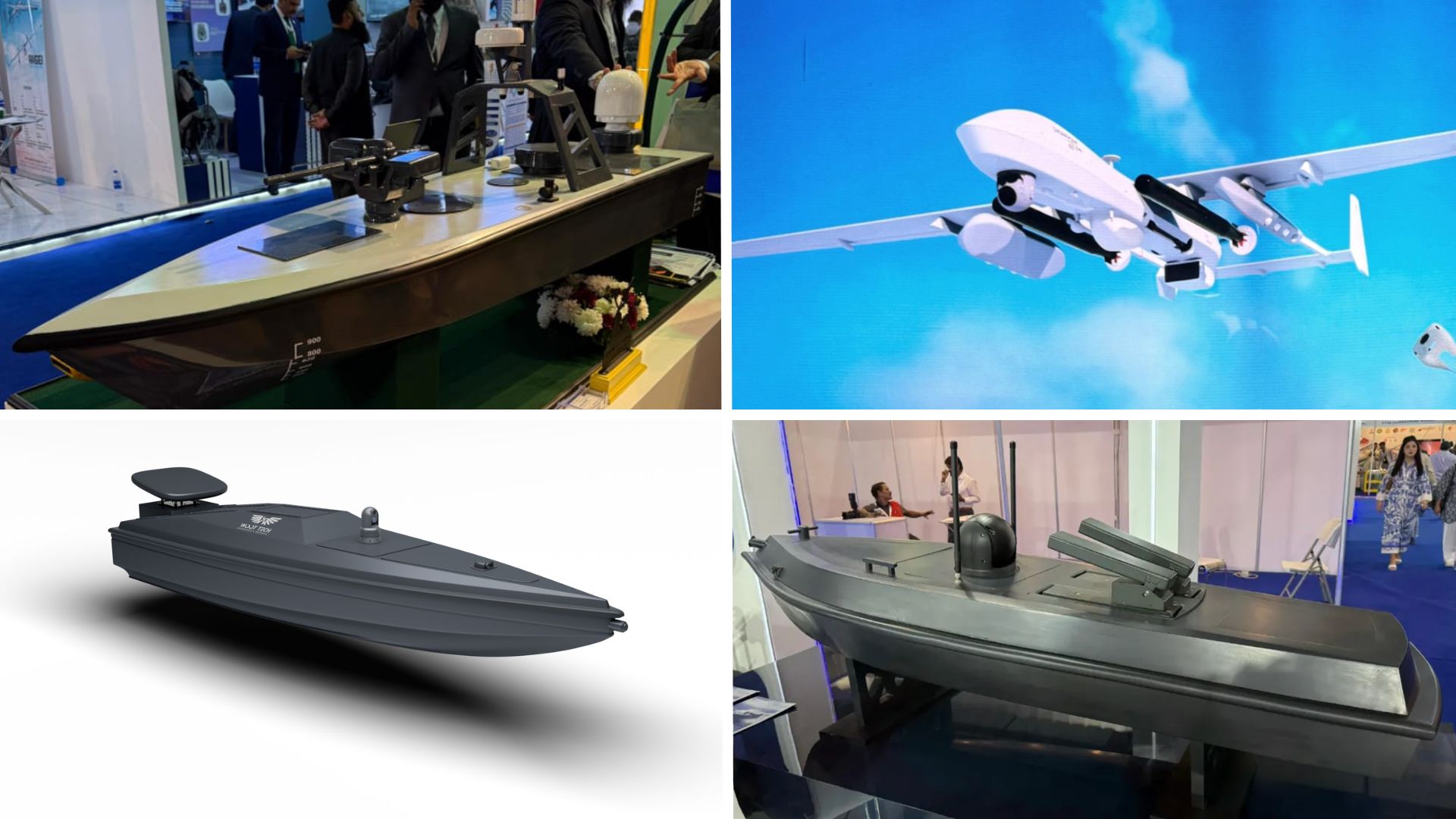
Pakistan Revealed New Naval Drones. Does it Signal a New Shift? Quwa Premium
At the 2025 Pakistan International Maritime Expo and Conference (PIMEC 2025), Pakistani defence industry firms showcased the unmanned aerial system (UAS), unmanned surface vehicle (USV) and autonomous underwater vehicle (AUV) designs they are currently developing.
These included the Stingray Technologies USV, as well as the Beyond Koncept “Muhassir” USV and “Israr” AUV. While marketed by seemingly private companies, each of these platforms appears to be in development at one of the National Engineering and Scientific Commission’s (NESCOM) entities.
NESCOM is the leading state-owned defence research, development, and production entity, with an ecosystem of subsidiaries specializing in different domains. One can see many NESCOM solutions in the product catalogues of Stingray Technologies and Beyond Koncept, thus revealing their actual nature as commercial arms of their respective NESCOM bureaus.
Global Industrial and Defence Solutions (GIDS), which generally works as the sales and marketing hub of NESCOM, also revealed a maritime variant of its forthcoming Shahpar III UAS. Interestingly, the concept videos of the maritime variant showcase a redesigned front fuselage alongside a series of specialized equipment, including sonobuoys, Eghraaq lightweight torpedoes, a synthetic aperture radar (SAR), and electronic and communications intelligence (ELINT/COMINT) suites.
Overall, the fact that no less than four different unmanned platforms are in development specifically for maritime purposes – i.e., three combat-capable USVs, at least one unmanned underwater vehicle (UUV)/AUV, and medium-altitude long-endurance (MALE) UAS – highlights how much more emphasis the Pakistan Navy (PN) is placing on uncrewed systems for its long-term procurement roadmap.
In July, the PN leadership stated that it will pursue uncrewed systems for its surface, sub-surface, and airborne requirements – each of these concepts serves as proof of Naval Headquarters’ (NHQ) seriousness in the matter.
Unmanned Surface Vessels (USV)
Beyond Koncept Muhassir USV
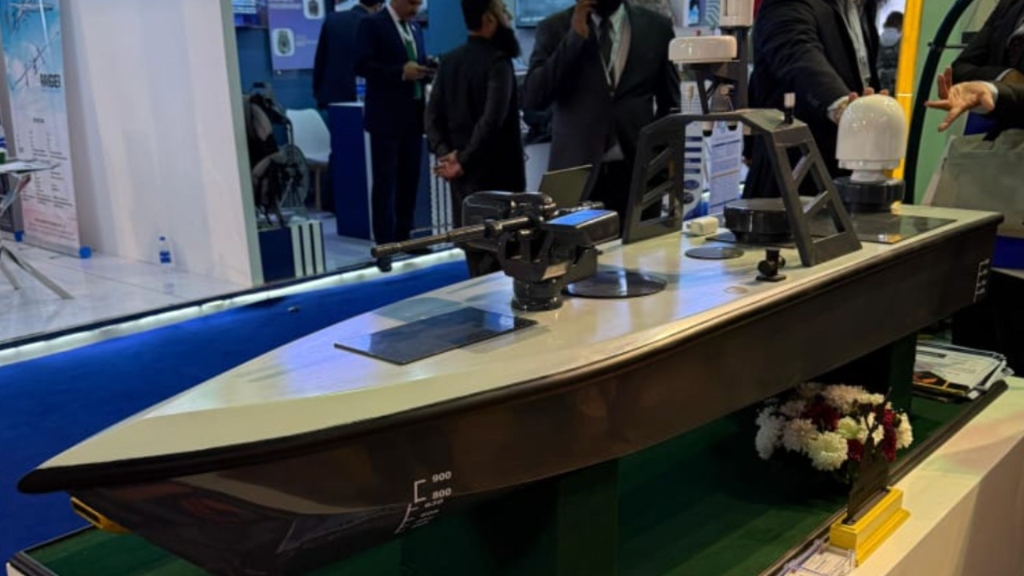
The Muhassir USV has an overall length of 10 m and a displacement of 7.3 tons. It is capable of reaching a speed of up to 40 knots and a cruise speed of 30 knots via waterjet propulsion. The Muhassir offers a stated endurance of over 400 nautical miles.
Overall, the Muhassir is best viewed as an intelligence, surveillance, and reconnaissance (ISR) platform that is also equipped with a basic weapon (i.e., 12.7 mm automatic gun via a remote-weapon station or RWS). However, its configuration – i.e., a navigation/search radar, an electro-optical (EO) turret, LiDAR, panoramic cameras, GNSS, INS, and Automatic Identification System (AIS) places a much stronger emphasis on providing situational awareness.
In fact, this subsystem selection and configuration indicate that the PN issued a comprehensive requirements set, one emphasizing an effective sensing, navigation, and connectivity stack. The inclusion of a SATCOM terminal, dedicated RF antennas, and optronics suggests that the PN wants to build long-endurance, networked operations via USVs rather than a bare-minimum remote-operated boat.
With a range of 400+ nautical miles, the Muhassir was likely designed to operate well beyond Pakistani harbours. If deployed from PN bases in Karachi, Ormara, or Gwadar, it can patrol most parts of Pakistan’s coastline, sit on key approaches to those ports, and even loiter along main arteries of Pakistan’s sea lanes for persistent ISR.
That said, the explicitly marketed “explosives hatch” is a noticeable design choice as it hints at a latent one-way strike role for the USV that, otherwise, would be reusable. It could be a possible sign that a future derivative of the Muhassir will be designed as a kamikaze USV with a bow charge, giving the PN a pathway for a MAGURA-like attack capability without starting from a clean sheet.
Stingray Technologies' USV
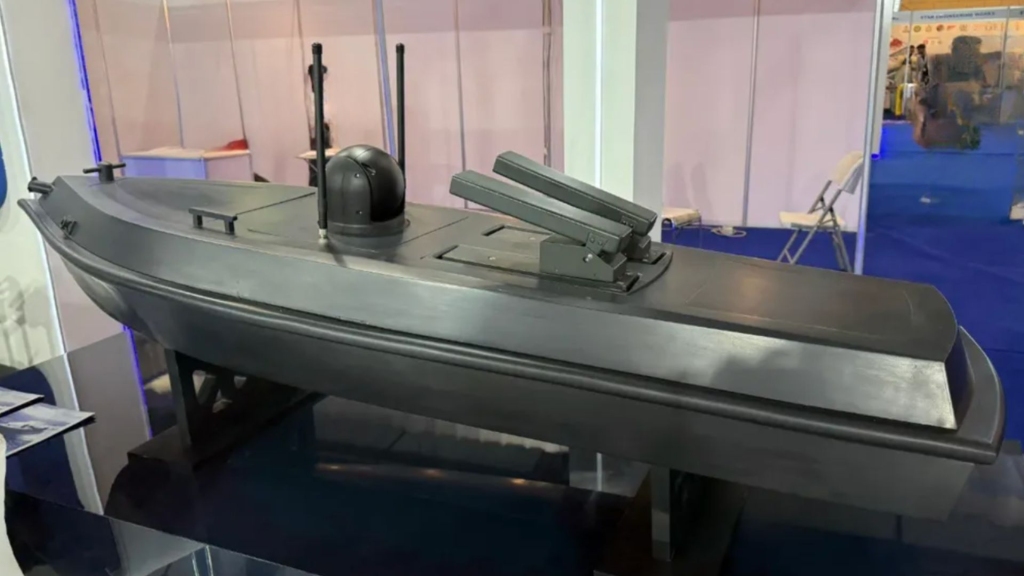
Interestingly, another NESCOM entity also showcased its own USV, but it did not disclose most of its specifications. This USV has a total length of 7.62 m and offers an endurance of four to five hours, but is also armed with a guided munitions capability (potentially four small surface-to-surface rockets/small missiles).
In the absence of specific details, it is difficult to compare this USV to the Muhassir, but the model suggests that the designers took a much simpler, lower-profile approach. The armament indicates that this USV was designed with the strike role in mind from the outset. Not only that, but the very low freeboard and dark, smooth deck indicate a focus on reducing its visibility, especially at night.
In fact, the topside fit is minimal, with only a single EO turret, several small stubs that are likely antennas, and two rectangular housings for potentially electronic or warhead payloads. But unlike the Muhassir, this USV does not have a tall mast, radome, RWS, or SATCOM. The tagline, “Unmanned. Unseen. Unstoppable,” also reinforces the idea of stealth and speed more so than feature-rich capabilities.
Thus, this design may be the first clear indication that Pakistan is working on a Magura-style littoral attacker. This would likely function via pre-planned routes (using GNSS/INS), and when in the terminal stage or strike area, a switch (via radio-based line-of-sight control) to manual control would be implemented. Thus, in addition to the rockets, this USV may also have an explosives hatch so that it could carry a payload for kamikaze missions. This USV – with its lighter subsystems load, stealthier profile, and shorter endurance – seems to be attritable in nature, rather than recoverable.
Woot-Tech Corsair
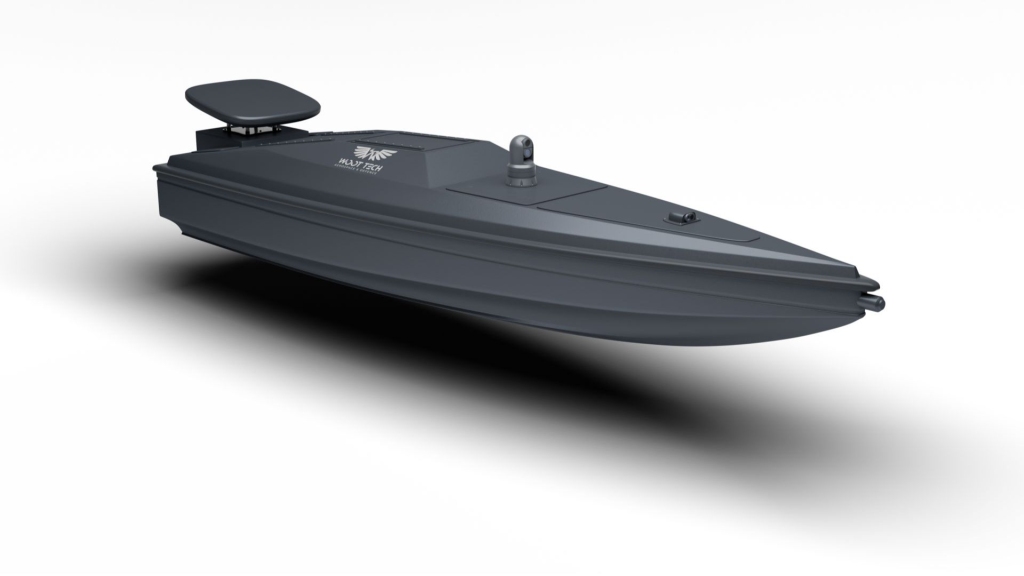
Pakistan’s private sector is also entering the USV space. The Corsair by Woot-Tech is being marketed as a kamikaze platform designed for engaging “up-armoured ships and port structures without being easily detected or intercepted.”
According to Woot-Tech, the Corsair can reach 30 knots, carries a 50 kg payload, and offers a range of about 100 nautical miles. It has an overall length of 4 m and an endurance of three hours.
Given its advertised role, one can reasonably infer that the Corsair’s subsystem fit prioritizes guidance and control over extensive sensor usage. The most likely configuration would involve GNSS/INS-based navigation, coupled with a small EO turret for terminal guidance under operator control.
The description of the Corsair as difficult to detect and intercept also hints at a low-profile hull with minimal mast or superstructure (which can also be seen in the design concept), trading persistent ISR and long-range connectivity for a reduced radar and visual signature.
In effect, the Corsair is closer to a ‘pure’ kamikaze boat (analogous to the Magura) than a multi-mission USV like the Muhassir. In this sense, the Stingray Technologies USV might occupy an ‘either/or’ function, as it can be configured for different roles, but with a stronger focus on deploying munitions rather than serving as one.
Practically, the Corsair may promise lower procurement costs and, in turn, the capacity to scale in larger numbers (e.g., for swarming missions and attritability as a result of the kamikaze mission).
Unmanned Aerial Vehicle (UAV)
Shahpar 3 Maritime Variant (?)
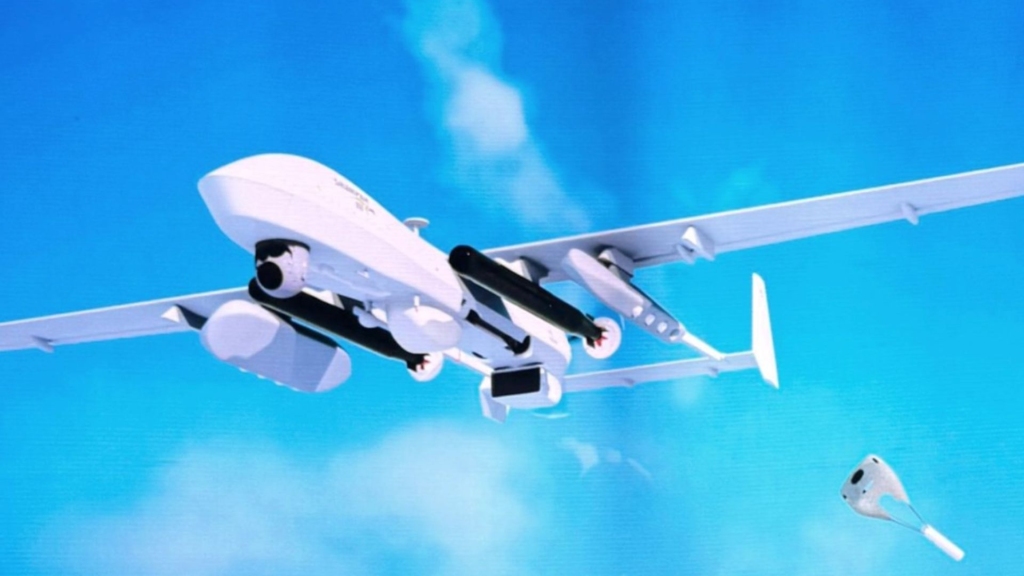
The Shahpar-3 maritime configuration, showcased at PIMEC 2025, features a navalized or generally enhanced variant of the drone. The idea that it would be configured with lightweight torpedoes, sonobuoy pods, and specialized sensors was revealed at the 2024 International Defence Exhibition and Seminar (IDEAS 2024).
Instead, the actual shift is the play to present a pre-integrated maritime solution. The naval variant appears to have an improved or modified front fuselage – whether this is a general improvement or a specifically designed measure to prevent salt erosion is unclear. Interestingly, the design was not yet shown with the planned anti-ship warfare (AShW) capability via the Rasoob 250 air-launched cruise missile (ALCM).
Overall, the Shahpar-3 will likely be positioned as a high-endurance maritime patrol and anti-submarine warfare (ASW) asset. The PN may be interested in using it as a complementary system with its forthcoming Sea Sultan long-range maritime patrol aircraft (LRMPA), enabling it to extend and intensify coverage without relying strictly on high-value, crewed aircraft.
End of excerpt. You’ll need to login or subscribe to Quwa Premium to access the full article.
Existing Quwa Plus/Pro members can log in below
Note: Logged in members may need to refresh the article page to see the article.
Related Reads
- Offshore Patrol Vessels (OPV) Will Play a Key Role in the Future of the Pakistan Navy Fleet.
- Extending Deterrence: How the Hangor-Class Reshapes Pakistan’s Maritime A2/AD Posture
- The COTS Advantage of the Pakistan Navy’s Sea Sultan LRMPA
- After a Decade of Growth, the Real Test for Pakistan’s Navy Has Begun


